Severe Acute SARS-CoV-2 Infection and Long COVID: What Do We Know So Far? New Challenges in Diagnosis and Management
Abstract
1. Introduction
2. Materials and Methods
- Study design
- Sample and setting
- −
- General objective examination, with a focus on the objective examination of the chest;
- −
- Neurological examination;
- −
- Measurement of blood pressure, heart rate and oxygen saturation;
- −
- Measurement of body weight;
- −
- Lung ultrasound: the presence of A lines corresponds to a picture of healing while the detection of multifocal, separate or confluent B lines or consolidations indicates the persistence of inflammation;
- −
- Evaluation of lung imaging through CT or X-ray reports performed at the Ancona hospital or in other facilities;
- −
- Evaluation of blood chemistry tests performed at the Ancona hospital or in the laboratories of other facilities;
- −
- Consultation of reports regarding pathologies of different specialist relevance such as dermatological visit, physiatric visit, ENT visit, ophthalmological visit;
- −
- Consultation of spirometry and Diffusing Capacity of the Lungs for Carbon Monoxide (DLCO) reports; these examination were performed by local pneumologist according to the guidelines of American Thoracic Society and European Respiratory Society Technical Statement [14];
- −
- Consultation of cardiological visit reports.
- Inclusion criteria
- Exclusion criteria
- Statistical analysis
3. Results
3.1. First Outcome
- −
- In 20 (40%), the persistence of the accentuation of the broncho-interstitial pattern;
- −
- In 6 (12%), dysventilatory streaks;
- −
- In 24 (48%), almost complete resolution of parenchymal thickening and reduction in broncho-interstitial network thickening.
- −
- In 20 cases (30%), almost complete resolution of the inflammatory picture;
- −
- In 36 cases (54%), a situation of slight improvement, with reduction in the consolidation aspects but permanence of the GG areas, or a stationary picture;
- −
- In 11 cases (16%), dysventilatory fibrotic streaks and micronodularity.
- −
- Complete resolution in 3 patients (50%);
- −
- Diffuse accentuation of the broncho-interstitial pattern in 2 patients (33%);
- −
- Accentuation of the pulmonary interstitium with the presence of dysventilatory/dysalectatic streaks in 1 patient (17%).
- −
- Complete resolution in 4 patients (19%);
- −
- Slight improvement with reduction in the areas of consolidation but permanence of the ground-glass areas in 13 patients (48%);
- −
- Dysventilatory streaks and micronodularity in 9 patients (33%);
3.2. Second Outcome
4. Discussion
5. Conclusions
Author Contributions
Funding
Institutional Review Board Statement
Informed Consent Statement
Data Availability Statement
Conflicts of Interest
References
- Ledford, H. How common is long COVID? Why studies give different answers. Nature 2022, 606, 852–853. [Google Scholar] [CrossRef]
- Augustin, M.; Schommers, P.; Stecher, M.; Felix, D.; Lutz, G.; Henning, G.; Carola, H.; Kanika, V.; Di Cristanziano, V.; Osebold, L.; et al. Post-COVID syndrome in non- hospitalised patients with COVID-19: A longitudinal prospective cohort study. Lancet Reg. Health Eur. 2021, 6, 100122. [Google Scholar] [CrossRef]
- Callard, F.; Perego, E. How and why patients made Long Covid. Soc. Sci. Med. 2021, 268, 113426. [Google Scholar] [CrossRef]
- Carfì, A.; Bernabei, R.; Landi, F.; Gemelli Against COVID-19 Post-Acute Care Study Group. Persistent Symptoms in Patients After Acute COVID-19. JAMA 2020, 324, 603–605. [Google Scholar] [CrossRef]
- CDC. Post-COVID Conditions. Centers for Disease Control and Prevention. Available online: https://www.cdc.gov/long-covid/about/index.html?CDC_AA_refVal=https%3A%2F%2Fwww.cdc.gov%2Fcovid%2Flong-term-effects%2Findex.html (accessed on 19 July 2022).
- Soriano, J.B.; Murthy, S.; Marshall, J.C.; Relan, P.; Diaz, J.V. A clinical case definition of post-COVID-19 condition by a Delphi consensus. Lancet Infect. Dis. 2022, 22, e102–e107. [Google Scholar] [CrossRef]
- Fernández-de-las-Peñas, C.; Palacios-Ceña, D.; Gómez-Mayordomo, V.; Cuadrado, M.L.; Florencio, L.L. Defining Post-COVID Symptoms (Post-Acute COVID, Long COVID, Persistent Post-COVID): An Integrative Classification. Int. J. Environ. Res. Public Health 2021, 18, 2621. [Google Scholar] [CrossRef] [PubMed]
- Mehandru, S.; Merad, M. Pathological sequelae of long-haul COVID. Nat. Immunol. 2022, 23, 194–202. [Google Scholar] [CrossRef]
- Shen, W.X.; Luo, R.C.; Wang, J.Q.; Chen, Z.S. Features of Cytokine Storm Identified by Distinguishing Clinical Manifestations in COVID-19. Front. Public Health 2021, 9, 671788. [Google Scholar] [CrossRef]
- Staffolani, S.; Iencinella, V.; Cimatti, M.; Tavio, M. Long COVID-19 syndrome as a fourth phase of SARS-CoV-2 infection. Infez. Med. 2022, 30, 22–29. [Google Scholar] [PubMed]
- Castanares-Zapatero, D.; Chalon, P.; Kohn, L.; Dauvrin, M.; Detollenaere, J.; de Noordhout, C.M.; Jong, C.P.-D.; Cleemput, I.; Van den Heede, K. Pathophysiology and mechanism of long COVID: A comprehensive review. Ann. Med. 2022, 54, 1473–1487. [Google Scholar] [CrossRef] [PubMed]
- Queiroz, M.A.F.; Neves, P.F.M.; Lima, S.S.; Lopes, J.d.C.; Torres, M.K.d.S.; Vallinoto, I.M.V.C.; de Brito, M.T.F.M.; da Silva, A.L.S.; Leite, M.d.M.; da Costa, F.P.; et al. Cytokine Profiles Associated with Acute COVID-19 and Long COVID-19 Syndrome. Front. Cell. Infect. Microbiol. 2022, 12, 922422. [Google Scholar] [CrossRef]
- Iqbal, F.M.; Lam, K.; Sounderajah, V.; Clarke, J.M.; Ashrafian, H.; Darzi, A. Characteristics and predictors of acute and chronic post-COVID syndrome: A systematic review and meta-analysis. eClinicalMedicine 2021, 36, 100899. [Google Scholar] [CrossRef] [PubMed]
- Graham, B.L.; Steenbruggen, I.; Miller, M.R. Standardization of Spirometry 2019 Update. An Official American Thoracic Society and European Respiratory Society Technical Statement. Am. J. Respir. Crit. Care Med. 2019, 200, e70–e88. [Google Scholar] [CrossRef] [PubMed]
- Ojo, A.S.; Balogun, S.A.; Williams, O.T.; Ojo, O.S. Pulmonary Fibrosis in COVID-19 Survivors: Predictive Factors and Risk Reduction Strategies. Pulm. Med. 2020, 2020, 6175964. [Google Scholar] [CrossRef] [PubMed]
- Dhawan, R.T.; Gopalan, D.; Howard, L.; Vicente, A.; Mirae, P.; Kavina, M.; Wallner, I.; Marsden, P.; Surendra, D.; Howard, B. Beyond the clot: Perfusion imaging of the pulmonary vasculature after COVID-19. Lancet Respir. Med. 2021, 9, 107–116. [Google Scholar] [CrossRef]
- John, A.E.; Joseph, C.; Jenkins, G.; Tatler, A.L. COVID-19 and pulmonary fibrosis: A potential role for lung epithelial cells and fibroblasts. Immunol. Rev. 2021, 302, 228–240. [Google Scholar] [CrossRef]
- Garcia-Revilla, J.; Deierborg, T.; Venero, J.L.; Boza-Serrano, A. Hyperinflammation and Fibrosis in Severe COVID-19 Patients: Galectin-3, a Target Molecule to Consider. Front. Immunol. 2020, 11, 2022. [Google Scholar] [CrossRef]
- Bulfamante, G.P.; Perrucci, G.L.; Falleni, M.; Sommariva, E.; Tosi, D.; Martinelli, D.; Songia, P.; Poggio, P.; Carugo, S.; Pompilio, G. Evidence of SARS-CoV-2 Transcriptional Activity in Cardiomyocytes of COVID-19 Patients without Clinical Signs of Cardiac Involvement. Biomedicines 2020, 8, E626. [Google Scholar] [CrossRef]
- Dani, M.; Dirksen, A.; Taraborrelli, P.; Torocastro, M.; Panagopoulos, D.; Sutton, R.; Lim, P. Autonomic dysfunction in “long COVID”: Rationale, physiology and management strategies. Clin. Med. Lond. Engl. 2021, 21, e63–e67. [Google Scholar] [CrossRef]
- Lopez-Leon, S.; Wegman-Ostrosky, T.; Perelman, C.; Sepulveda, R.; Rebolledo, P.; Cuapio, A.; Villapol, S. More than 50 Long-term effects of COVID-19: A systematic review and meta-analysis. Sci. Rep. 2021, 11, 16144. [Google Scholar] [CrossRef]
- Diotallevi, F.; Mazzanti, S.; Properzi, P.; Olivieri, S.; Giacometti, A.; Offidani, A. Is there a POST-COVID dermatological syndrome? The integrated dermato-infectious disease experience of a single centre. J. Eur. Acad. Dermatol. Venereol. 2022, 36, e166–e169. [Google Scholar] [CrossRef] [PubMed]
- Taquet, M.; Geddes, J.R.; Husain, M.; Luciano, S.; Harrison, P.J. 6-month neurological and psychiatric outcomes in 236 379 survivors of COVID-19: A retrospective cohort study using electronic health records. Lancet Psychiatry 2021, 8, 416–427. [Google Scholar] [CrossRef] [PubMed]
- Linda, N.G.; Kristine, M.E.; Mady, H.; Letts, R.; Selvaggi, C.; Ashktorab, H.; Atieh, O.; Bartram, L.; Brim, H.; Brosnahan, S. 2024 Update of the RECOV-ER-Adult Long COVID Research Index. JAMA 2025, 333, 694–700. [Google Scholar]
- Rizzetto, G.; Diotallevi, F.; Campanati, A.; Radi, G.; Bianchelli, T.; Molinelli, E.; Mazzanti, S.; Offidani, A. Telogen effluvium related to post severe Sars-CoV-2 infection: Clinical aspects and our management experience. Dermatol. Ther. 2021, 34, e14547. [Google Scholar] [CrossRef] [PubMed]
- Wong, T.; Weitzer, D.J. Long COVID and Myalgic Encephalomyelitis/Chronic Fatigue Syndrome (ME/CFS)-A Systemic Review and Comparison of Clinical Presentation and Symptomatology. Medicina 2021, 57, 418. [Google Scholar]
- Bertolini, A.; van de Peppel, I.P.; Bodewes, F.A.J.A.; Moshage, H.; Fantin, A.; Farinati, F.; Fiorotto, R.; Jonker, J.W.; Strazzabosco, M.; Verkade, H.J.; et al. Abnormal Liver Function Tests in Patients with COVID-19: Relevance and Potential Pathogenesis. Hepatology 2020, 72, 1864–1872. [Google Scholar] [CrossRef]
- Terpos, E.; Ntanasis-Stathopoulos, I.; Elalamy, I.; Efstathios, K.; Theodoros, N.; Politou, M.; Psaltopoulou, T.; Gerotziafas, G.; Dimopoulos, M. Hematological findings and complications of COVID-19. Am. J. Hematol. 2023, 2020, 834–847. [Google Scholar] [CrossRef]
- Montefusco, L.; Ben Nasr, M.; D’Addio, F.; Loretelli, C.; Rossi, A.; Pastore, I.; Daniele, G.; Abdelsalam, A.; Maestroni, A.; Dell’aCqua, M.; et al. Acute and long-term disruption of glycometabolic control after SARS-CoV-2 infection. Nat. Metab. 2021, 3, 774–785. [Google Scholar] [CrossRef]
- Khizroeva, J.H.; Makatsariya, A.D.; Bitsadze, V.O.; Tretyakova, M.V.; Slukhanchuk, E.V.; Elalamy, I.; Gris, J.C.; Radetskaya, L.S.; Makatsariya, N.A.; Sulina, Y.Y.; et al. Laboratory monitoring of COVID-19 patients and importance of coagulopathy markers. Obstet. Gynecol. Reprod. 2020, 14, 132–147. [Google Scholar] [CrossRef]
- Jackson, D.; Shymaa, E.B.; Chaterine, Y.; Ahmed, E. Exproring the complexities of Long COVID. Viruses 2024, 16, 1060. [Google Scholar]
- Joseph, M.B. Long COVID: A consequence of chronic post-infectious inflammation! Expert Rev. Respir. Med. 2024, 18, 939–945. [Google Scholar] [CrossRef]
- Michael, R.M.; Ravinda, G.; Thomas, J.B.; Ryan, T.H. Long COVID: Emerging patophysiological mechanism. Minerva Med. 2025, 116, 156–165. [Google Scholar]
- Chrysanthu, S.; Charalampos, D.M.; Paraskevi, C.F.; Karsten, G.; Elisabeth, S.; Bernard, S. Long COVID: Pathophysiology, current concepts and future directions. J. Allergy Clin. Immunol. 2025, 155, 1059–1070. [Google Scholar]
- Muhammad, M.I.; Ayesha, I.; Rachael, A. Long COVID update: Respiratory sequelae and symptoms. Curr. Opin. Support. Palliat. Care 2025, 19, 95–102. [Google Scholar] [CrossRef] [PubMed]
- Dinah, V.P. Lond COVID or Post-Acute Sequelae od Sars-CoV-2 Infection (PASC) and the Urgent Need to Identify Diagnostic Biomarkers and Risk Factors. Med. Sci. Monit. 2024, 18, 30. [Google Scholar]
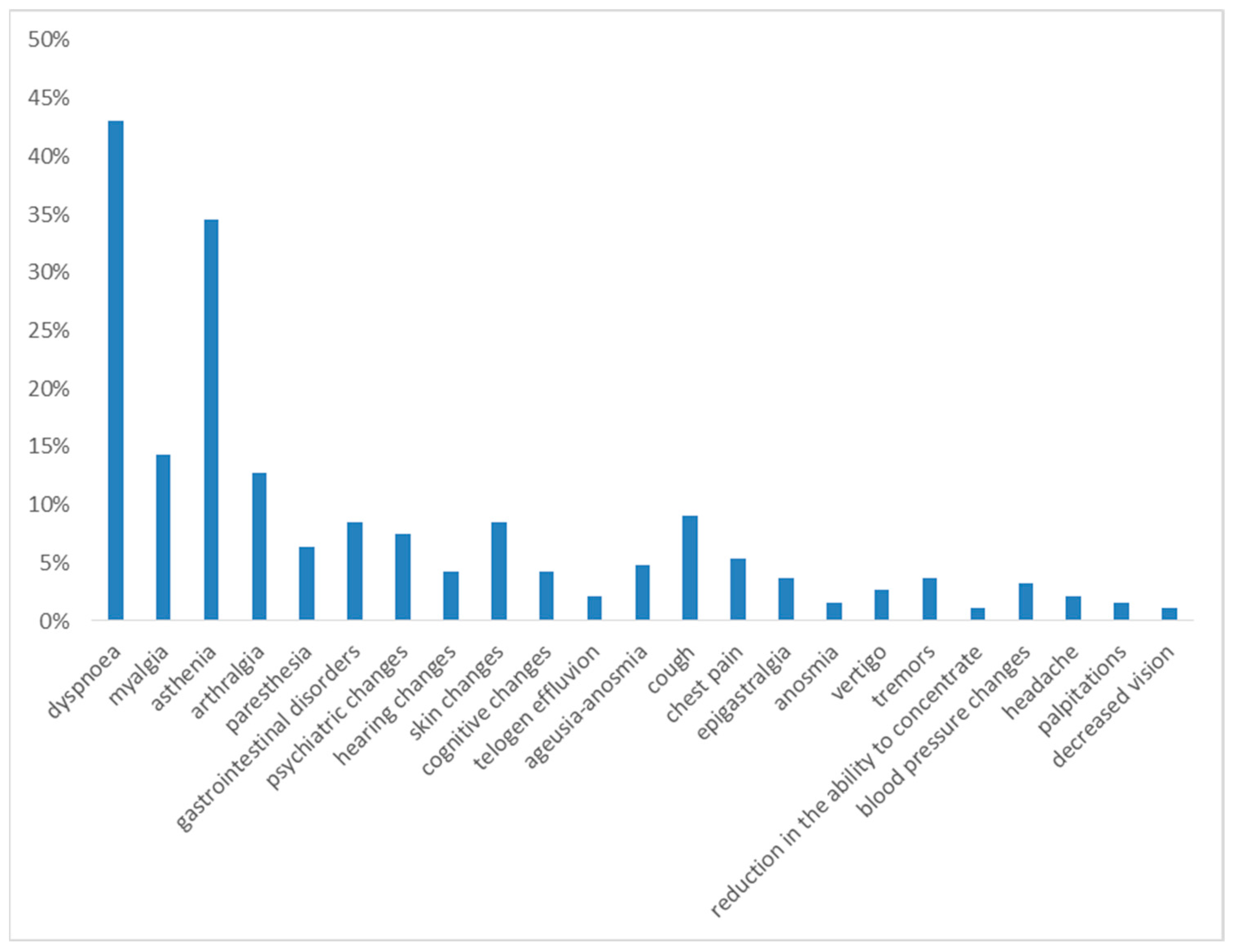
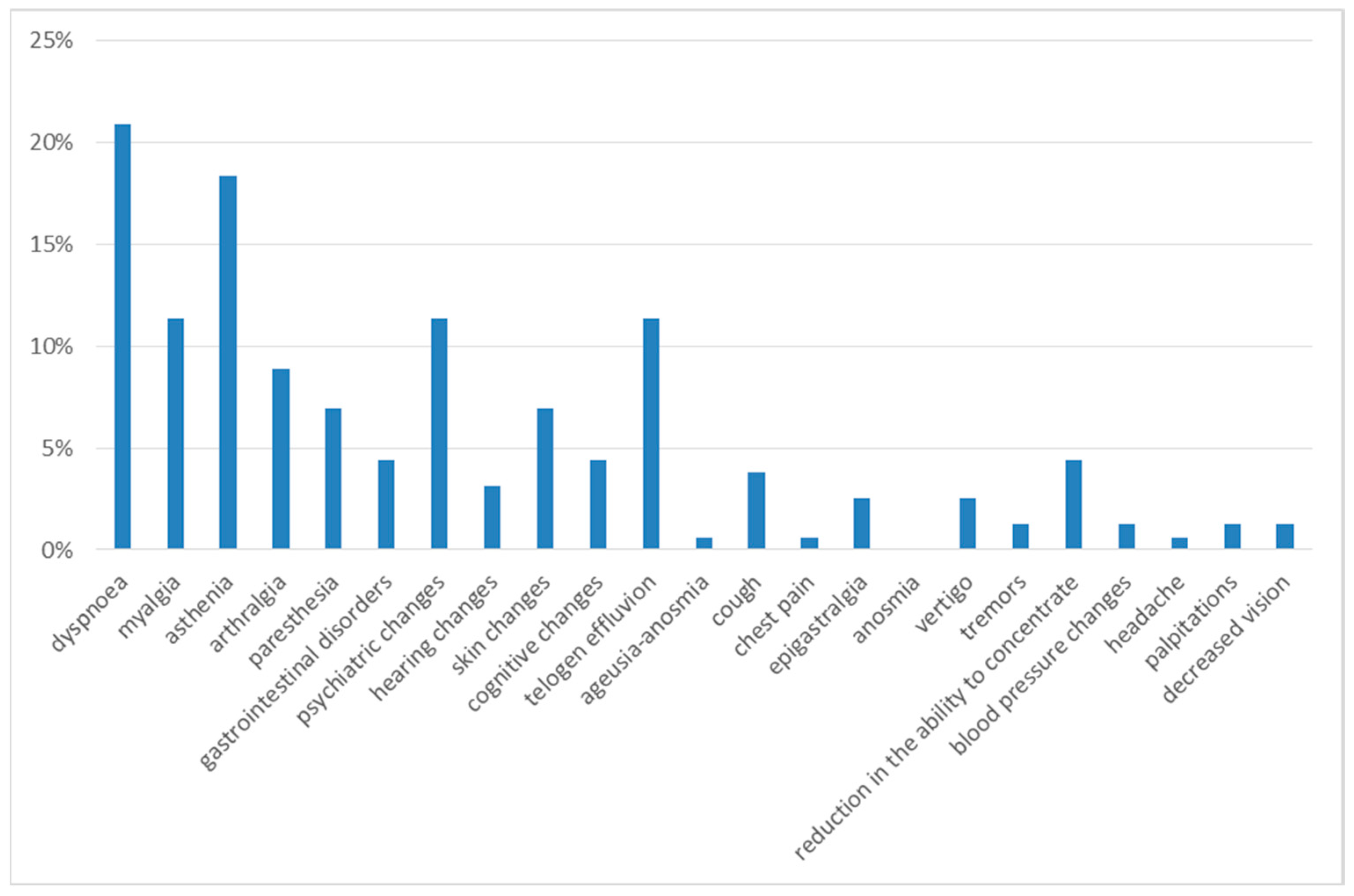

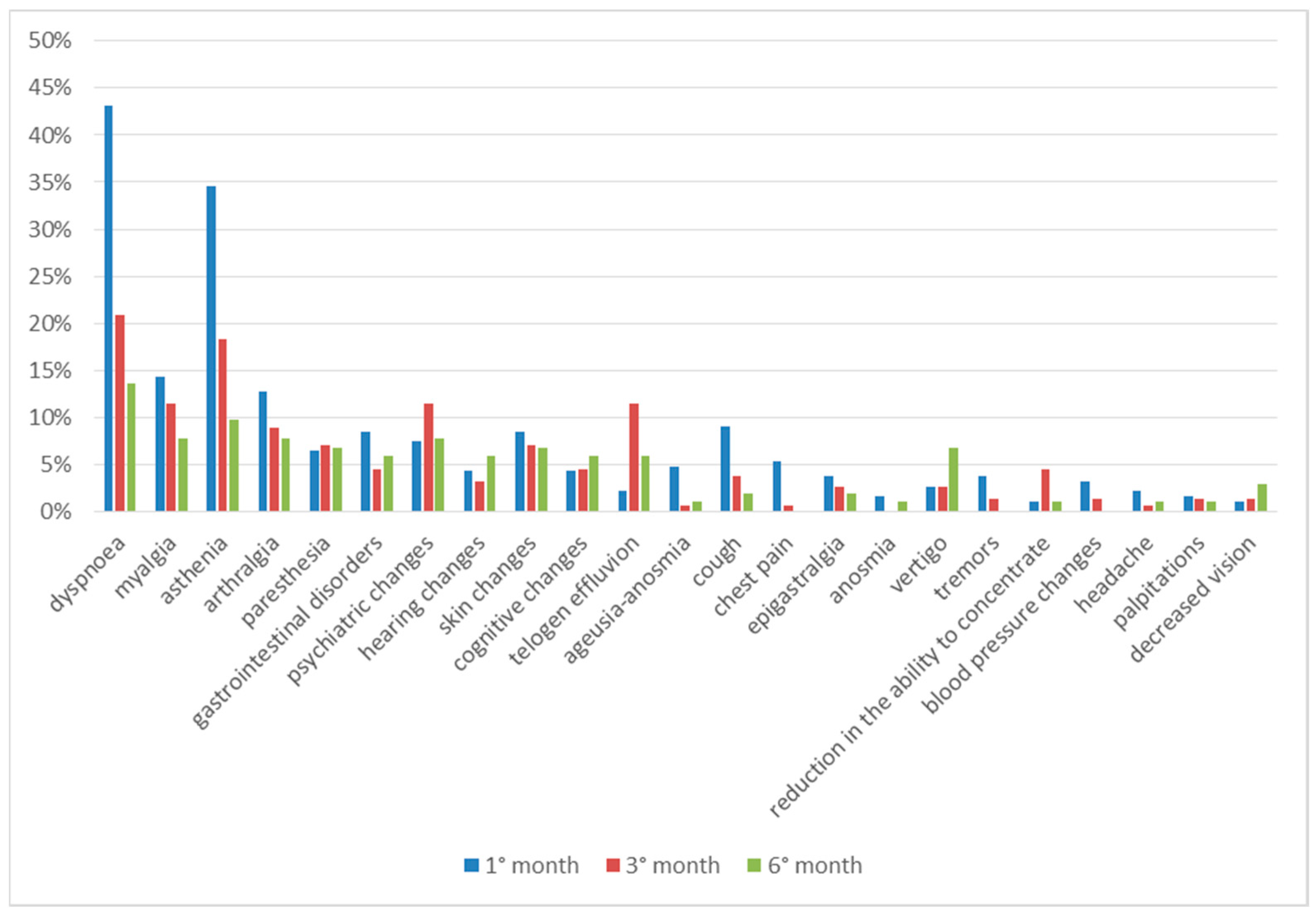
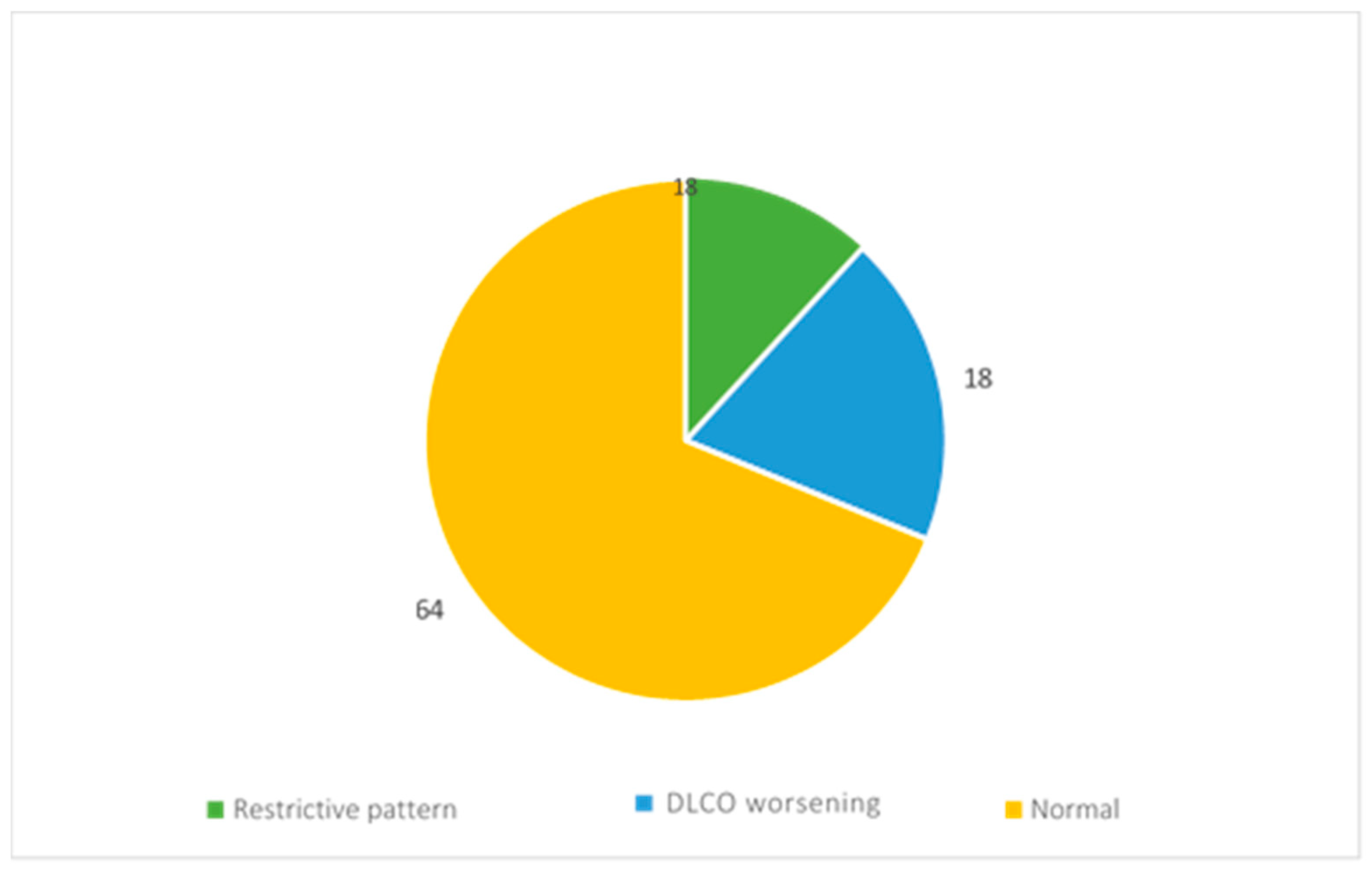
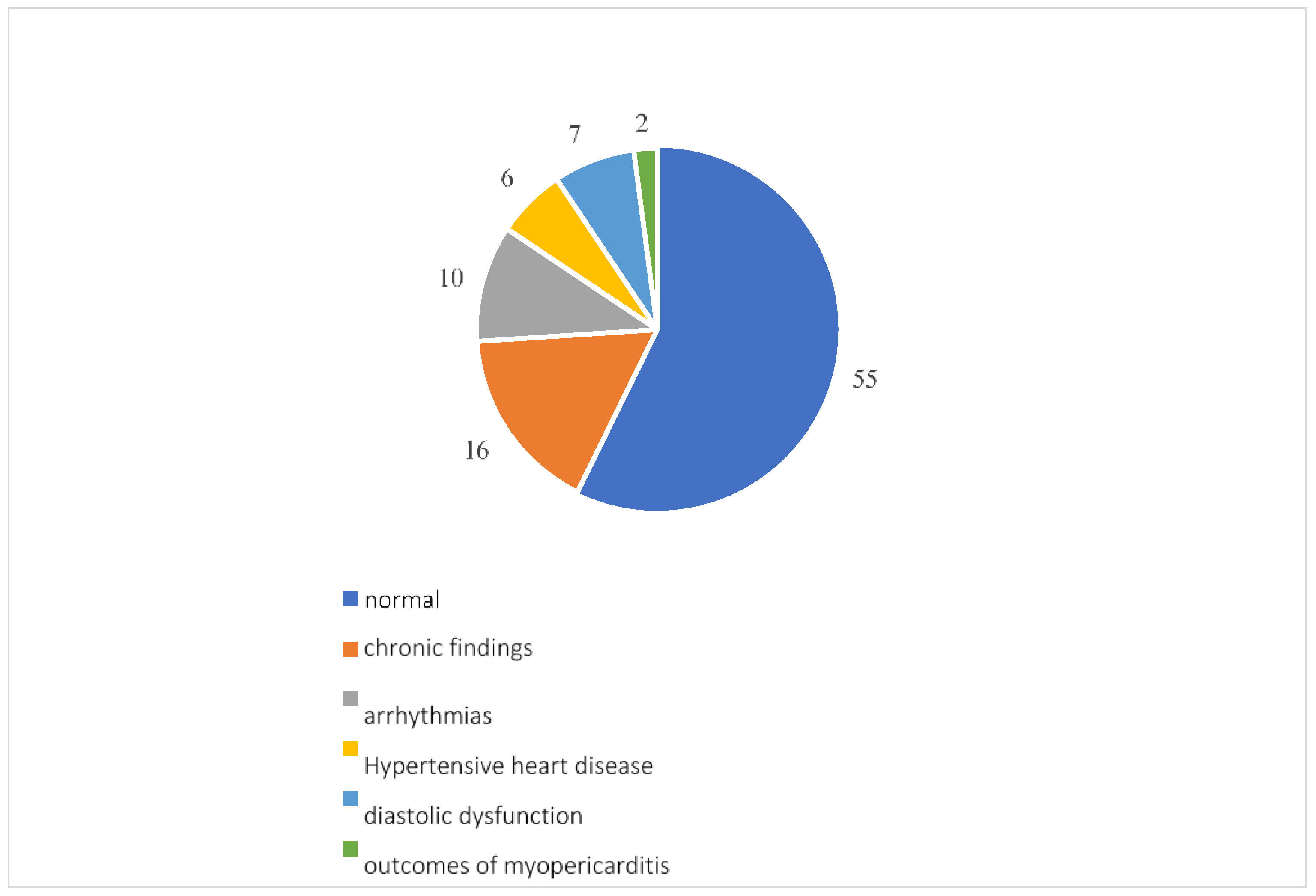
| Characteristics of Patients | n (%) |
|---|---|
| Male, n (%) | 111 (58) |
| Age, median (IQR) | 61 (50–71) |
| BMI, median (IQR) | 25 (23–28) |
| Acute comorbidities | |
| Arrhythmia, n (%) | 8 (4) |
| Ischemia, n (%) | 2 (1) |
| Bacterial pneumonia, n (%) | 4 (2) |
| Pulmonary embolism, n (%) | 11 (6) |
| TVP (deep vein thrombosis), n (%) | 5 (2) |
| Bacterial coinfection, n (%) | 4 (2) |
| ARDS, n (%) | 17 (9) |
| Anemia, n (%) | 74 (39) |
| Coagulation abnormalities, n (%) | 29 (15) |
| Pneumothorax, n (%) | 4 (2) |
| Myositis, n (%) | 2 (1) |
| Pleural effusion, n (%) | 15 (8) |
| Acute kidney failure, n (%) | 15 (8) |
| Pancreatitis, n (%) | 11 (6) |
| Meningitis, n (%) | 2 (1) |
| Liver disease, n (%) | 65 (34) |
| Heart failure, n (%) | 8 (4) |
| Confusion, n (%) | 17 (9) |
| Pericarditis, n (%) | 2 (1) |
| Coinfection in other sides, n (%) | 32 (17) |
| Septic shock n (%) | 6 (3) |
| Rash, n (%) | 4 (2) |
| Chronic comorbidities, n (%) | |
| Previous hospitalization, n (%) | 40 (21) |
| Malnutrition, n (%) | 10 (5) |
| Previous pneumonia (previous 5 years), n (%) | 10 (5) |
| BPCO, n (%) | 15 (8) |
| HIV, n (%) | 2 (1) |
| Hypertension, n (%) | 84 (44) |
| Cardiac diseases, n (%) | 38 (20) |
| Diabetes mellitus, n (%) | 27 (14) |
| Dyslipidemia, n (%) | 36 (19) |
| Neurological diseases, n (%) | 32 (13) |
| Dialysis, n (%) | 2 (1) |
| Solid tumors n (%) | 6 (3) |
| Hematological malignancies, n (%) | 2 (1) |
| Chronic kidney failure, n (%) | 13 (7) |
| Liver chronic diseases, n (%) | 6 (3) |
| Asplenia, n (%) | 2 (1) |
| Solid organ transplant, n (%) | 2 (1) |
| Parameters | Tested Patients (n) | Patients with Laboratory Abnormalities (n) | % |
|---|---|---|---|
| Leucocyte 103/µL | 160 | 18 | 11% |
| Erythrocyte 106/µL | 163 | 67 | 41% |
| Hemoglobin g/dL | 161 | 37 | 23% |
| Platelets 103/µL | 159 | 10 | 6% |
| PCR mg/dL | 159 | 32 | 20% |
| D-dimer ng/mL | 151 | 47 | 31% |
| Interleukine-6 pg/mL | 138 | 75 | 54% |
| Fibrinogen mg/dL | 59 | 49 | 83% |
| ALT U/L | 159 | 53 | 33% |
| Total cholesterol mg/dL | 152 | 88 | 58% |
| Triglycerides mg/dL | 149 | 62 | 42% |
| Glycemia mg/dL | 136 | 30 | 22% |
| HDL mg/dL | 70 | 14 | 20% |
| LDL mg/dL | 61 | 33 | 54% |
| Electrophoresis | 80 | 11 | 14% |
| LDH U/L | 141 | 19 | 13% |
| CPK U/L | 154 | 7 | 5% |
| Parameters | Tested Patients (n) | Patients with Laboratory Abnormalities (n) | % |
|---|---|---|---|
| Leucocyte 103/µL | 139 | 8 | 6% |
| Erythrocyte 106/µL | 139 | 29 | 21% |
| Hb g/dL | 138 | 19 | 14% |
| Platelets 103/µL | 128 | 12 | 9% |
| PCR mg/dL | 125 | 26 | 21% |
| D-dimer ng/mL | 61 | 25 | 41% |
| IL-6 pg/mL | 102 | 58 | 57% |
| Fibrinogen mg/dL | 5 | 3 | 60% |
| ALT U/L | 122 | 19 | 16% |
| Total cholesterol mg/dL | 115 | 54 | 47% |
| Triglycerides mg/dL | 112 | 28 | 25% |
| Glycemia mg/dL | 32 | 11 | 34% |
| HDL mg/dL | 70 | 19 | 27% |
| LDL mg/dL | 53 | 29 | 55% |
| Electrophoresis | 78 | 7 | 9% |
| LDH U/L | 120 | 31 | 26% |
| CPK U/L | 122 | 18 | 15% |
| Parameter | Tested Patients (n) | Patients with Laboratory Abnormalities (n) | % |
|---|---|---|---|
| Leucocyte 103/µL | 79 | 5 | 6% |
| Erythrocyte 106/µL | 80 | 21 | 26% |
| Hb g/dL | 80 | 10 | 13% |
| Platelets 103/µL | 77 | 10 | 13% |
| PCR mg/dL | 78 | 17 | 22% |
| D-dimer ng/mL | 47 | 20 | 43% |
| IL-6 pg/mL | 64 | 23 | 36% |
| Fibrinogen mg/dL | 1 | 0 | 0% |
| ALT U/L | 82 | 10 | 8% |
| Total cholesterol mg/dL | 58 | 23 | 40% |
| Triglycerides mg/dL | 59 | 18 | 31% |
| Glycemia mg/dL | 13 | 5 | 38% |
| HDL mg/dL | 33 | 9 | 27% |
| LDL mg/dL | 24 | 12 | 50% |
| Electrophoresis | 35 | 3 | 9% |
| LDH U/L | 72 | 23 | 32% |
| CPK U/L | NA | NA | NA |
| Patients with Asthenia (28) | Patients Without Asthenia (115) | p | |
|---|---|---|---|
| White blood cells > 8000 (n,%) | 4 (14) | 8 (7) | 0.01 |
| PCR > 5 (n,%) | 8 (28) | 30 (26) | 0.9 |
| LDH > 300 (n,%) | 3 (11) | 21 (18) | 0.4 |
| CPK > 300 (n,%) | 4 (14) | 12 (10) | 0.06 |
| ALT > 40 (n,%) | 9 (32) | 12 (10) | 0.01 |
| IL-6 > 10 (n,%) | 2 (7) | 24 (20) | 0.08 |
| Patients with Dyspnea (32) | Patients Without Dyspnea (110) | p | |
|---|---|---|---|
| White blood cells > 8000 (n,%) | 1 (3) | 11 (10) | 0.5 |
| PCR > 5 (n,%) | 5 (16) | 34 (30) | 0.2 |
| LDH > 300 (n,%) | 6 (19) | 18 (16) | 0.09 |
| CPK > 300 (n,%) | 4 (14,2) | 12 (11) | 0.8 |
| ALT > 40 (n,%) | 4 (14) | 18 (16) | 0.9 |
| IL-6 > 10 (n,%) | 7 (25) | 19 (16) | 0.5 |
Disclaimer/Publisher’s Note: The statements, opinions and data contained in all publications are solely those of the individual author(s) and contributor(s) and not of MDPI and/or the editor(s). MDPI and/or the editor(s) disclaim responsibility for any injury to people or property resulting from any ideas, methods, instructions or products referred to in the content. |
© 2025 by the authors. Licensee MDPI, Basel, Switzerland. This article is an open access article distributed under the terms and conditions of the Creative Commons Attribution (CC BY) license (https://creativecommons.org/licenses/by/4.0/).
Share and Cite
Mazzanti, S.; Barchiesi, F.; Pallotta, F.; Luchetti, I.; Giacometti, A.; Brescini, L. Severe Acute SARS-CoV-2 Infection and Long COVID: What Do We Know So Far? New Challenges in Diagnosis and Management. Diseases 2025, 13, 337. https://doi.org/10.3390/diseases13100337
Mazzanti S, Barchiesi F, Pallotta F, Luchetti I, Giacometti A, Brescini L. Severe Acute SARS-CoV-2 Infection and Long COVID: What Do We Know So Far? New Challenges in Diagnosis and Management. Diseases. 2025; 13(10):337. https://doi.org/10.3390/diseases13100337
Chicago/Turabian StyleMazzanti, Sara, Francesco Barchiesi, Francesco Pallotta, Ilenia Luchetti, Andrea Giacometti, and Lucia Brescini. 2025. "Severe Acute SARS-CoV-2 Infection and Long COVID: What Do We Know So Far? New Challenges in Diagnosis and Management" Diseases 13, no. 10: 337. https://doi.org/10.3390/diseases13100337
APA StyleMazzanti, S., Barchiesi, F., Pallotta, F., Luchetti, I., Giacometti, A., & Brescini, L. (2025). Severe Acute SARS-CoV-2 Infection and Long COVID: What Do We Know So Far? New Challenges in Diagnosis and Management. Diseases, 13(10), 337. https://doi.org/10.3390/diseases13100337




